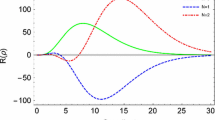Abstract
A fundamental tenet of general relativity is geodesic motion of point particles. For extended objects, however, tidal forces make the trajectories deviate from geodesic form. In fact Mathisson, Papapetrou, and others have found that even in the limit of very small size there exists a residual curvature-spin force. Another important physical case is that of field theory. Here the ray (WKB) approximation may be used to obtain the equation of motion. In this article I consider an alternative procedure, the proper time translation operator formalism, to obtain the covariant Heisenberg equations for the quantum velocity, momentum, and angular momentum operators for the case of spinor fields. I review the flat spacetime results for Dirac particles in Yang-Mills fields, where we recover the Lorentz force. For curved spacetime I find that the geodesic equation is modified by an additional term involving the spin tensor, and the parallel transport equation for the momentum is modified by an additional term involving the curvature tensor. This curvature term is the “Lorentz force” of the gravitational field. The main result of this article is that these equations are exactly the (symmetrized) Mathisson-Papapetrou equations for the quantum operators. Extension of these results to the case of spin-one fields may be possible by use of the KDP formalism.
Similar content being viewed by others
REFERENCES
M. Mathisson, Acta Phys. Pol. 6, 163 (1937).
A. Papapetrou, Proc. Roy. Soc. London A 209, 248 (1951).
F. A. E. Pirani, Acta Phys. Pol. 15, 389 (1956).
W. G. Dixon, Proc. Roy. Soc London A 314, 499 (1970); 319, 509 (1970); Gen. Relat. Gravit. 4, 199 (1973); Philos. Trans. Roy. Soc. London A 277, 59 (1974).
C. W. Misner, K. S. Thorne, and J. A. Wheeler, Gravitation (Freeman, San Francisco, 1973), pp. 570-577, and references therein.
J. Audretsch, J. Phys. A: Math. Gen. 14, 411 (1981); Phys. Rev. D 24, 1470 (1981).
R. Rudiger, Proc. Roy. Soc. London A 377, 417 (1981).
R. Spinosa, Class. Quantum Gravit. 4, 473 (1986); Ann. Phys. ( Leipzig ) 46, 179 (1989); Class. Quantum Gravit. 4, 1799 (1987).
M. Seitz, Class. Quantum Gravit. 3, 1265 (1986).
H. Hönl and A. Papapetrou, Z. Phys. 112, 512 (1939); 114, 478 (1939); 116, 153 (1940).
E. Corinaldesi and A. Papapetrou, Proc. Roy. Soc. London A 209, 259 (1951).
J. Schwinger, Phys. Rev. 82, 669 (1951).
V. Fock, Phys. Z. Sov. U. 12, 404 (1937).
Y. Nambu, Prog. Theor. Phys. 5, 82 (1950).
G. Szamosi, Nuovo Cimento 20, 1090 (1961).
A. O. Barut, A. J. Bracken, and W. D. Thacker, Lett. Math. Phys. 8, 477 (1984); A. O. Barut and W. D. Thacker, Phys. Rev. D 31, 1386 (1985); Phys. Rev. D 31, 2076 (1985).
H. Rumpf, in Cosmology and Gravitation: Spin, Torsion, Rotation, and Supergravity, P. Bergman and V. deSabbata, eds. ( Plenum, New York, 1980), pp. 93-104.
J. Anandan, Nuovo Cimento A 53, 221 (1979).
See for example: A Messiah, Quantum Mechanics, Vol. I (Wiley, New York, 1958), p. 70; L. Schiff, Quantum Mechanics (McGraw-Hill, New York, 1968), p. 176.
E. Schrodinger, Sitzungsber. Akad. Phys. 57, 261 (1929).
H. Weyl, Z. Phys. 56, 330 (1929).
V. Fock and D. Ivanenko, C. R. Acad Sci. (Paris) 188, 1470 (1929).
R. Utiyama, Phys. Rev. 101, 1597 (1956).
T. W. B. Kibble, J. Math. Phys. 2, 212 (1961).
D. W. Sciama, in Recent Developments in General Relativity (Permagon, Oxford, 1962).
J. P. Crawford, in Clifford (Geometric) Algebras with Applications to Physics, Mathematics, and Engineering, W. E. Baylis, ed. (Birkhaäuser, Boston, 1996), Chaps. 23 and 24; see also Adv. Appl. Clifford Alg. 2, 75 (1992).
N. Kemmer, Helv. Phys. Acta 10, 47 (1937); Proc. Roy. Soc. London A 166, 127 (1938); Proc. Cambridge Philos. Soc. 34, 354 (1938). R. J. Duffin, Phys. Rev. 54, 1114 (1938); Phys. Rev. 77, 683 (1950). A. Proca, J. Phys. Radium 7, 347 (1936); 9, 61 (1938).
Rights and permissions
About this article
Cite this article
Crawford, J.P. Spinor Matter in a Gravitational Field: Covariant Equations à la Heisenberg. Foundations of Physics 28, 457–470 (1998). https://doi.org/10.1023/A:1018768128810
Issue Date:
DOI: https://doi.org/10.1023/A:1018768128810




